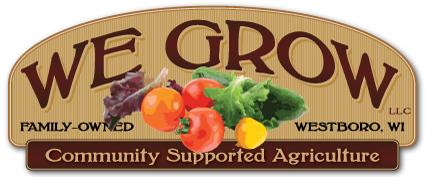Buying a farm share can be a hard decision to make. We want to help you with the decision by asking you the six most important questions.

Meet your farmers, Eric Rebecca, Gus and Dene
1>>> Is a relationship with a farm and it’s farmers important to you?
There are SO many options of what to buy or who to buy from these days. How much does it matter that you’re supporting a local, family-operated farm? As a farm share member, you are an integral part of our farm. You can celebrate with us when we have bumper crops and be disappointed with us when we experience a rough hand from nature. When you buy a farm share, We Grow becomes your farm and we become your farmers. Do you want a relationship with a local farm?
2>>> Does taste and quality of vegetables matter to you?
Can you remember the first time you ate a farm-fresh tomato and realized all of the other tomatoes you had eaten before were watery and had no taste? Do you know that there are different flavors of lettuce and even different colors, each one has slightly different nutrition. To ensure fresh and delicious produce, we use special harvesting and handling techniques and are stewards of the soil. When the soil is healthy, plants thrive and vegetables have more flavor. If you find yourself disappointed with produce at grocery stores or craving something better, our farm share may be for you.

Spring share items prepped for sauteing. Green garlic, scallions, and pea shoots.
3>>> Are you open to trying new foods?
Are you adventurous? Willing to test out a new recipe? Are you open to finding out more about yourself and what vegetables you like and dislike? If you are, our farm share may be the perfect way to discover more about yourself this year. We’ll be sending you a box of veggies every week and you may not like everything we send you. That’s ok. We all have different tastes and preferences. What’s important is that you’re willing to try. As long as you’re open to trying new things, being part of our farm share will be an experience you won’t forget. It may even change your life!
4>>> Are you flexible with meal planning?
One of our favorite parts of the farm share is the seasonality. When we eat seasonally, it makes every season feel like a celebration! But eating seasonally requires us to be a bit spontaneous when it comes to meal planning. We may have to adapt if the zucchini harvest is massive or if carrots aren’t quite ready. While meal planning is definitely still possible with a farm share, it requires more flexibility since the veggies available to you change week-by-week. To help you with meal planning, we’ll let you know what we plan on sending early in the week so you can have time to plan. We’ll also share recipes we’ve found and tested. Another great way to get a meal planning boost is to encourage friends or co-workers to join the farm share so you can bounce ideas off one another! Join other farm share holders on our private Facebook group to jumpstart your meal planning.
5>>> Do you have patience to learn how to be a farm share member?
The key word in this question is learn. Cooking with seasonal vegetables may take practice and require learning a new skill set, but it is a learning process. You don’t need to be a master at the beginning, all you need is patience with yourself and a desire to learn and grow. As the season goes, we’ll help you with providing tips and recipes, especially since we’ll be eating the exact same veggies as you!

Know where your food comes from and appreciate the process of regenerative farming and sustainable, organic growing practices.
6>>> Do you value food?
We all love a good deal. I often wish I could bargain for goods and services. However, since becoming a farmer, I’ve learned about the value of a product, specifically food. I’ve learned when we undervalue food, it negatively affects many other parts of society. A farm share is an investment for half of the year; an investment into your health, a local economy, food security, and a two-way relationship between farm and customer. By buying a farm share, you’re saying that food has value and how the food is grown matters.
You don’t have to be an ace in the kitchen the day you pick up your first box of veggies. All you have to do is learn, practice, and try. If you answered most of the questions with a “yes,” then you would be the perfect farm member! Commit to a farm share today! If you are still on the fence, consider trying out our custom CSA Market Share instead of a traditional CSA Share. Learn more >>

![]()















